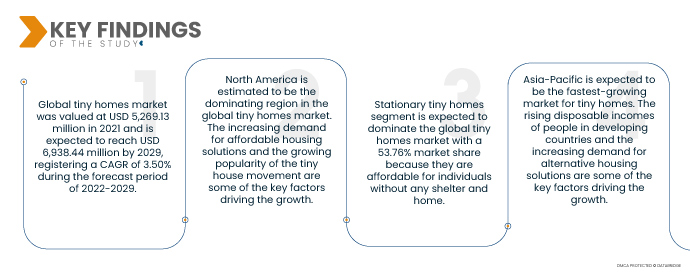Tiny houses have evolved over the last few decades and now come in a variety of styles and designs that appeal to people from all walks of life, including retirees, first-time homebuyers, and young minimalists, among others. Tiny homes offer a variety of high-quality, moderately priced, and environmentally responsible living solutions that can be used to meet individual aspirations, financial and lifestyle goals, and social needs. It delivers several major benefits to consumers and the communities in which they live, including cheaper purchasing costs, less waste from construction materials, a smaller carbon footprint, and much less energy use.
Access Full Report @ https://www.databridgemarketresearch.com/reports/global-tiny-homes-market
Global Tiny Homes Market was valued at USD 5,269.13 million in 2021 and is expected to reach USD 6,938.44 million by 2029, registering a CAGR of 3.50% during the forecast period of 2022-2029. Tiny homes are significantly more affordable than traditional homes. This is due to the fact that they require less materials and labor to build. Tiny homes are more sustainable than traditional homes. This is because they require less energy and water and produce less waste. Tiny homes can be stylish and modern. They can be customized to meet the needs and preferences of the individual homeowner. These market drivers are expected to continue to fuel the growth of the global tiny homes market in the coming years.

Growing personal disposable income and improving affordability rates is expected to drive the market's growth rate
The affordability of tiny homes is one of the key factors driving their growth. In the United States, the median price of a new home is over $300,000. This is out of reach for many people, especially millennials who are struggling to save for a down payment. Tiny homes, on the other hand, can be purchased for as little as $20,000. This makes them an affordable option for people looking for a place to live but don't have a lot of money. Tiny homes can also be stylish and modern. They can be customized to meet the needs and preferences of the individual homeowner. Some tiny homes are designed to be mobile, while others are designed to be stationary. Some tiny homes are designed for full-time living, while others are designed for vacation or retirement use.
Report Scope and Market Segmentation
|
Report Metric
|
Details
|
|
Forecast Period
|
2022 to 2029
|
|
Base Year
|
2021
|
|
Historic Years
|
2020 (Customizable to 2014- 2019)
|
|
Quantitative Units
|
Revenue in USD Million, Volumes in Units, Pricing in USD
|
|
Segments Covered
|
Product Type (Mobile Tiny Homes and Stationary Tiny Homes), Area (Less Than 130 Sq. Ft., 130-500 Sq. Ft., and More Than 500 Sq. Ft.), Application (Household, Commercial, Industrial, and Others), Distribution Channel (Direct Sales and Distributors)
|
|
Countries Covered
|
U.S., Canada and Mexico in North America, Germany, France, U.K., Netherlands, Switzerland, Belgium, Russia, Italy, Spain, Turkey, Rest of Europe in Europe, China, Japan, India, South Korea, Singapore, Malaysia, Australia, Thailand, Indonesia, Philippines, Rest of Asia-Pacific (APAC) in the Asia-Pacific (APAC), Saudi Arabia, U.A.E, South Africa, Egypt, Israel, Rest of Middle East and Africa (MEA) as a part of Middle East and Africa (MEA), Brazil, Argentina and Rest of South America as part of South America
|
|
Market Players Covered
|
Skyline Champion Corporation (U.S.), Nestron (Singapore), The Tiny Housing Co. (U.K.), THE QUBE (Australia), TIMBERCARAFT TINY HOMES (U.S.), CargoHome (U.S.), ATLAS VANS (U.S.), Oregon Cottage Company (U.S.), Tiny Home Builders (U.S.), Tiny SMART House, Inc. (U.S.), Tumbleweed Tiny House Company (U.S.), New Frontier Tiny Homes (U.S.), Mustard Seed Tiny Homes LLC (U.S.), MAVERICK TINY HOMES, LLC (U.S.), California Tiny House (U.S.), American Tiny House (U.S.)
|
|
Data Points Covered in the Report
|
In addition to the market insights such as market value, growth rate, market segments, geographical coverage, market players, and market scenario, the market report curated by the Data Bridge Market Research team includes in-depth expert analysis, import/export analysis, pricing analysis, production consumption analysis, and consumer behaviour
|
Segment Analysis:
The global tiny homes market is segmented into four notable segments based on product type, area, application, and distribution channel.
- On the basis of product type, the global tiny homes market is segmented into mobile tiny homes and stationary tiny homes. Stationary tiny homes segment is expected to dominate the global tiny homes market with a 53.76% market share because they are affordable for individuals without any shelter and home. They are less expensive in terms of taxes and building, energy consumption, maintenance, and repair costs. They embrace an eco-friendly living and sustainable lifestyle.
- On the basis of area, the global tiny homes market is segmented into less than 130 sq. ft., 130-500 sq. ft., and more than 500 sq. ft. 130-500 sq. ft. segment is expected to dominate the global tiny homes market with a 48.88% market share because they are cheaper than conventional homes as they take up less square footage. They can be built with recycled and sustainable materials. Also, they can resolve the concerns regarding affordable living and make life easier for many people.
- On the basis of application, the global tiny homes market is segmented into household, commercial, industrial, and others. Household segment is expected to dominate the global tiny homes market with a 49.22% market share because they are an affordable and sustainable housing solution for households without any shelter and home. They are cheaper and economical compared to traditional homes.
The household segment will dominate the application segment of the tiny homes market
The household segment will emerge as the dominating segment application segment. This is because of the growing demand for tiny homes in the market especially in the developing economies. Further, growth and expansion of research development services on a global scale will further bolster the growth of this segment.
- On the basis of distribution channel, the global tiny homes market is segmented into direct sales and distributors. Direct sales segment is expected to dominate the global tiny homes market with a 53.43% market share because they do not involve any intermediary and facilitate a direct relationship between the manufacturer and the customer. It is beneficial in obtaining feedback directly from the customers, thereby improving the quality of the products.
The direct sales segment will dominate the distribution channel segment of the tiny homes market
The direct sales segment will emerge as the dominating segment under distribution channel. This is because of the growing number of infrastructural development activities in the market especially in the developing economies. Further, growth and expansion of the FMCG industry all around the globe will further bolster the growth of this segment.
Major Players
Data Bridge Market Research recognizes the following companies as the major market players: Skyline Champion Corporation (U.S.), Nestron (Singapore), The Tiny Housing Co. (U.K.), THE QUBE (Australia), TIMBERCARAFT TINY HOMES (U.S.), CargoHome (U.S.), ATLAS VANS (U.S.), Oregon Cottage Company (U.S.), Tiny Home Builders (U.S.), Tiny SMART House, Inc. (U.S.), Tumbleweed Tiny House Company (U.S.), New Frontier Tiny Homes (U.S.), Mustard Seed Tiny Homes LLC (U.S.), MAVERICK TINY HOMES, LLC (U.S.), California Tiny House (U.S.), American Tiny House (U.S.).
Market Development
- In 2022, Skyline Champion Corporation was awarded three 2022 MHI Excellence in Manufactured and Modular Home Design awards by the Manufactured Housing Institute (MHI). This prestigious recognition is a testament to Skyline Champion's commitment to excellence in design, quality, and leadership. The awards were given for the company's innovative designs for the Tuscany, Berkshire, and Williamsburg manufactured homes. These homes feature modern layouts, energy-efficient construction, and luxurious amenities. The awards will help Skyline Champion to increase its brand image and encourage it to continue its tradition of excellence.
- In 2021, TIMBERCARAFT TINY HOMES introduced the Denali Bunkhouse, a mobile 3-bedroom tiny home. The Denali Bunkhouse features a main floor bedroom with a king-size bed, two sleeping lofts with a staircase, a fully furnished kitchen and bathroom with a bathtub, French doors, and vaulted ceilings. The Denali Bunkhouse is the perfect home for families or small groups who want to enjoy the freedom and flexibility of tiny home living. The introduction of the Denali Bunkhouse helped TIMBERCARAFT TINY HOMES to increase its product portfolio and appeal to a wider range of customers.
Regional Analysis
Geographically, the countries covered in the market report are U.S., Canada and Mexico in North America, Germany, France, U.K., Netherlands, Switzerland, Belgium, Russia, Italy, Spain, Turkey, Rest of Europe in Europe, China, Japan, India, South Korea, Singapore, Malaysia, Australia, Thailand, Indonesia, Philippines, Rest of Asia-Pacific (APAC) in the Asia-Pacific (APAC), Saudi Arabia, U.A.E, South Africa, Egypt, Israel, Rest of Middle East and Africa (MEA) as a part of Middle East and Africa (MEA), Brazil, Argentina and Rest of South America as part of South America.
As per Data Bridge Market Research analysis:
North America is the dominant region in the tiny homes market during the forecast period 2022-2029
North America is estimated to be the dominating region in the global tiny homes market. The increasing demand for affordable housing solutions and the growing popularity of the tiny house movement are some of the key factors driving the growth of the tiny homes market in North America.
Asia-Pacific is estimated to be the fastest growing region in the tiny homes market in the forecast period 2022-2029
Asia-Pacific is expected to be the fastest-growing market for tiny homes. The rising disposable incomes of people in developing countries such as China and India, and the increasing demand for alternative housing solutions are some of the key factors driving the growth of the tiny homes market in Asia-Pacific.
For more detailed information about the tiny homes market report, click here – https://www.databridgemarketresearch.com/reports/global-tiny-homes-market











